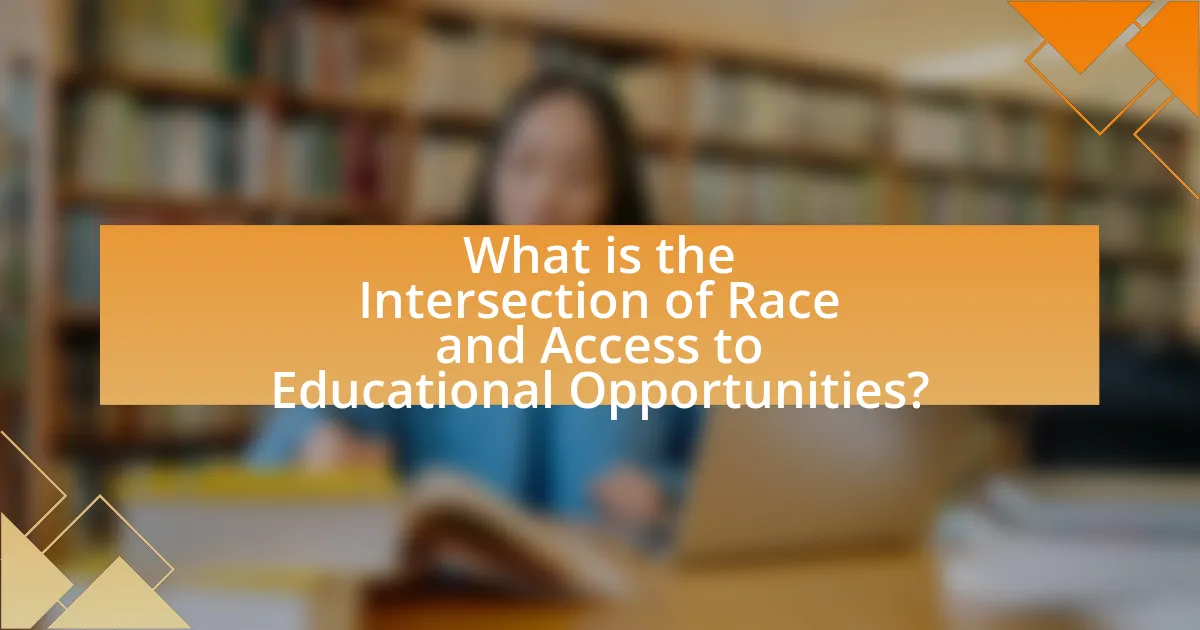The article examines the intersection of race and access to educational opportunities, highlighting how racial identity affects individuals’ ability to obtain quality education. It discusses systemic inequalities, such as funding disparities and discriminatory practices, that disproportionately impact students of color, leading to limited access to resources and advanced coursework. Historical contexts, socioeconomic factors, and cultural perceptions are explored as contributing elements to these disparities. The article emphasizes the importance of understanding these intersections for effective policy-making and educational equity initiatives, while also outlining strategies to improve access and support for marginalized groups.

What is the Intersection of Race and Access to Educational Opportunities?
The intersection of race and access to educational opportunities refers to the ways in which racial identity influences individuals’ ability to obtain quality education. Research indicates that systemic inequalities, such as funding disparities and discriminatory practices, disproportionately affect students of color, limiting their access to advanced coursework, experienced teachers, and essential resources. For instance, a report by the U.S. Department of Education found that schools serving predominantly Black and Hispanic students receive significantly less funding than those serving predominantly white students, which directly impacts educational outcomes. This intersection highlights the critical need for policies aimed at addressing these disparities to ensure equitable access to educational opportunities for all racial groups.
How does race influence access to educational resources?
Race significantly influences access to educational resources through systemic inequalities that affect funding, school quality, and availability of advanced courses. For instance, predominantly minority schools often receive less funding due to property tax-based funding models, leading to fewer resources such as textbooks, technology, and extracurricular programs. According to a 2019 report by the U.S. Government Accountability Office, schools with higher percentages of students of color are more likely to be underfunded compared to their predominantly white counterparts. This disparity in funding directly impacts the quality of education and opportunities available to students, perpetuating a cycle of disadvantage based on race.
What are the historical contexts affecting race and education?
The historical contexts affecting race and education include systemic racism, segregation laws, and discriminatory policies that have shaped educational access and quality for different racial groups. For instance, the Plessy v. Ferguson decision in 1896 established the “separate but equal” doctrine, which legitimized racial segregation in schools, leading to significant disparities in educational resources and opportunities for Black students compared to their white counterparts. Additionally, the Civil Rights Movement of the 1960s aimed to dismantle these inequities, resulting in landmark legislation such as the Civil Rights Act of 1964, which prohibited discrimination in education. Despite these advancements, ongoing issues such as socioeconomic disparities and school funding inequities continue to affect educational outcomes for racially marginalized groups, illustrating the persistent impact of historical contexts on race and education.
How do socioeconomic factors intersect with race in education?
Socioeconomic factors significantly intersect with race in education by influencing access to resources, quality of schools, and educational outcomes. For instance, students from low-income families, who are disproportionately from racial and ethnic minority groups, often attend underfunded schools with fewer experienced teachers and limited extracurricular opportunities. According to the National Center for Education Statistics, schools serving predominantly Black and Hispanic students receive about $23 billion less in funding than those serving predominantly white students. This funding disparity contributes to achievement gaps, as students in lower socioeconomic brackets face barriers such as inadequate facilities, lack of access to advanced coursework, and fewer support services. Thus, the intersection of race and socioeconomic status creates systemic inequities that hinder educational attainment for marginalized groups.
Why is understanding this intersection important?
Understanding the intersection of race and access to educational opportunities is crucial because it reveals systemic inequalities that affect marginalized communities. Research indicates that students from racially diverse backgrounds often face barriers such as underfunded schools and discriminatory practices, which hinder their academic success. For instance, a report by the National Center for Education Statistics shows that schools serving predominantly Black and Hispanic students receive significantly less funding than those serving predominantly white students. This disparity in resources directly impacts educational outcomes, making it essential to comprehend how race influences access to opportunities in education.
What implications does this have for policy-making?
The implications for policy-making regarding the intersection of race and access to educational opportunities include the necessity for targeted interventions to address systemic inequities. Policymakers must recognize that racial disparities in education can lead to long-term socioeconomic disadvantages, as evidenced by studies showing that students from marginalized racial backgrounds often have less access to quality educational resources, which in turn affects their academic performance and future opportunities. For instance, research by the National Center for Education Statistics indicates that schools in predominantly minority areas receive significantly less funding than those in predominantly white areas, highlighting the need for equitable funding policies. Therefore, effective policy-making must prioritize equitable resource allocation, inclusive curriculum development, and community engagement to ensure that all students have equal access to educational opportunities, regardless of their racial background.
How does this understanding affect educational equity initiatives?
Understanding the intersection of race and access to educational opportunities directly influences educational equity initiatives by highlighting systemic barriers that disproportionately affect marginalized groups. This understanding prompts policymakers and educators to implement targeted strategies, such as equitable funding models and culturally responsive curricula, aimed at addressing these disparities. Research indicates that schools serving predominantly minority populations often receive less funding and resources, which exacerbates educational inequities. For instance, a report from the U.S. Department of Education found that schools with high percentages of students of color are more likely to be underfunded compared to their predominantly white counterparts. Therefore, recognizing the impact of race on educational access is crucial for developing effective equity initiatives that strive to create a more just educational landscape.

What are the barriers to educational opportunities based on race?
Barriers to educational opportunities based on race include systemic inequities, socioeconomic disparities, and discriminatory practices. Systemic inequities manifest in underfunded schools predominantly attended by students of color, leading to fewer resources and lower-quality education. Socioeconomic disparities often result in limited access to advanced coursework, extracurricular activities, and college preparatory resources, which are more readily available in affluent, predominantly white neighborhoods. Discriminatory practices, such as racial bias in disciplinary actions and admissions processes, further hinder the academic success of students from marginalized racial backgrounds. For instance, a report from the U.S. Department of Education indicates that Black students are suspended and expelled at rates three times higher than their white peers, which negatively impacts their educational trajectory.
What systemic issues contribute to these barriers?
Systemic issues that contribute to barriers in access to educational opportunities include socioeconomic disparities, institutional racism, and inadequate funding for schools in marginalized communities. Socioeconomic disparities create unequal access to resources, such as tutoring and extracurricular activities, which are essential for academic success. Institutional racism manifests in discriminatory policies and practices that disadvantage students of color, leading to lower enrollment in advanced courses and higher dropout rates. Additionally, inadequate funding for schools predominantly serving low-income and minority students results in overcrowded classrooms, outdated materials, and insufficient support services, further hindering educational attainment. These factors collectively perpetuate a cycle of inequality in educational access and outcomes.
How do school funding disparities affect racial minorities?
School funding disparities negatively impact racial minorities by limiting their access to quality education and resources. Research indicates that schools in predominantly minority areas often receive significantly less funding than those in predominantly white areas, leading to larger class sizes, fewer advanced placement courses, and inadequate facilities. For instance, a report by the U.S. Government Accountability Office found that schools serving low-income students, who are disproportionately racial minorities, receive about $1,200 less per student than those serving wealthier populations. This funding gap contributes to lower academic achievement and reduced opportunities for higher education among racial minorities, perpetuating cycles of poverty and inequality.
What role does community support play in overcoming these barriers?
Community support plays a crucial role in overcoming barriers to educational opportunities, particularly for marginalized racial groups. It provides essential resources such as mentorship, financial assistance, and access to information that can help individuals navigate educational systems. For instance, studies have shown that community organizations often facilitate tutoring programs and college readiness workshops, which directly address gaps in academic preparation. Furthermore, community support fosters a sense of belonging and encouragement, which can enhance students’ motivation and resilience. Research indicates that students with strong community ties are more likely to pursue higher education and achieve academic success, demonstrating the significant impact of collective efforts in dismantling systemic obstacles.
How do cultural perceptions impact access to education?
Cultural perceptions significantly impact access to education by shaping attitudes towards learning and the value placed on education within different communities. For instance, in cultures that prioritize academic achievement, families are more likely to invest in educational resources and support for their children, leading to higher enrollment and retention rates in schools. Conversely, in cultures where education is undervalued or where traditional roles may prioritize work over schooling, children may face barriers to accessing educational opportunities. Research indicates that cultural beliefs about gender roles can also influence educational access; for example, in some societies, girls may be discouraged from pursuing education due to prevailing norms that prioritize male education. This dynamic is supported by studies such as the UNESCO Global Education Monitoring Report, which highlights how cultural attitudes directly correlate with educational participation rates across different demographics.
What stereotypes exist regarding race and academic ability?
Stereotypes regarding race and academic ability often suggest that certain racial groups are inherently more or less intelligent than others. For instance, the stereotype that Asian students excel academically is prevalent, leading to the perception that they are naturally gifted in subjects like mathematics and science. Conversely, stereotypes about Black and Latino students often imply lower academic potential, which can result in lowered expectations from educators and systemic biases in educational settings. Research by the American Psychological Association indicates that these stereotypes can negatively impact the academic performance of students who are aware of them, a phenomenon known as stereotype threat. This evidence illustrates how racial stereotypes can shape perceptions of academic ability and influence educational outcomes.
How can these perceptions be challenged to improve access?
Perceptions regarding race and access to educational opportunities can be challenged through targeted awareness campaigns and policy reforms. Awareness campaigns can educate stakeholders about systemic inequalities and the impact of racial biases on educational access, fostering a more inclusive environment. For instance, research by the National Center for Education Statistics indicates that minority students often face barriers that their peers do not, highlighting the need for tailored interventions. Policy reforms, such as implementing equitable funding models and affirmative action, can directly address disparities in access, as evidenced by studies showing that increased funding in under-resourced schools leads to improved educational outcomes for minority students.

What strategies can be implemented to improve access to educational opportunities?
To improve access to educational opportunities, implementing targeted scholarship programs and community-based mentorship initiatives is essential. Targeted scholarship programs can alleviate financial barriers for underrepresented students, as evidenced by the fact that students receiving financial aid are 50% more likely to enroll in college compared to those who do not receive aid. Community-based mentorship initiatives can provide guidance and support, helping students navigate educational pathways, which has been shown to increase high school graduation rates by up to 20% in diverse populations. These strategies directly address the systemic barriers faced by marginalized groups, fostering a more equitable educational landscape.
How can educational institutions address racial disparities?
Educational institutions can address racial disparities by implementing targeted support programs, equitable resource allocation, and inclusive curricula. Targeted support programs, such as mentorship and tutoring specifically designed for underrepresented students, have been shown to improve academic outcomes. For instance, a study by the National Bureau of Economic Research found that mentorship programs significantly increased college enrollment rates among minority students. Equitable resource allocation ensures that schools in underserved areas receive adequate funding and materials, which is crucial for leveling the playing field. Additionally, inclusive curricula that reflect diverse histories and perspectives can foster a more engaging learning environment, as evidenced by research from the University of California, which indicates that students exposed to diverse content perform better academically and socially.
What programs have been successful in promoting equity in education?
Successful programs promoting equity in education include the “Gaining Early Awareness and Readiness for Undergraduate Programs” (GEAR UP), which provides funding to support low-income students in preparing for college. GEAR UP has demonstrated effectiveness by increasing college enrollment rates among participants, with studies showing a 10% increase in college attendance compared to non-participants. Another notable program is “The Equity in Education Initiative,” which focuses on training educators to address implicit biases and create inclusive classrooms. Research indicates that schools implementing this initiative have seen improved academic outcomes for marginalized students, evidenced by a 15% increase in standardized test scores. These programs exemplify targeted efforts to enhance educational access and success for underrepresented groups.
How can teacher training be improved to support diverse student populations?
Teacher training can be improved to support diverse student populations by incorporating culturally responsive teaching practices. This approach equips educators with the skills to recognize and address the unique cultural backgrounds and learning needs of their students. Research indicates that culturally responsive training enhances teachers’ ability to engage with students from various racial and ethnic backgrounds, leading to improved academic outcomes. For instance, a study by Gay (2010) highlights that teachers who implement culturally relevant pedagogy foster a more inclusive classroom environment, which positively impacts student participation and achievement. By integrating these practices into teacher training programs, educational institutions can better prepare teachers to meet the diverse needs of their students.
What role do community organizations play in enhancing educational access?
Community organizations play a crucial role in enhancing educational access by providing resources, support, and advocacy for underserved populations. These organizations often offer tutoring, mentorship programs, and scholarships that directly address barriers to education, such as financial constraints and lack of academic support. For instance, a study by the National Center for Education Statistics found that community-based programs significantly improve educational outcomes for low-income students by increasing their engagement and academic performance. Additionally, community organizations advocate for policy changes that promote equitable access to educational resources, thereby addressing systemic inequalities related to race and socioeconomic status.
How can partnerships between schools and communities be strengthened?
Partnerships between schools and communities can be strengthened by fostering open communication and collaboration on shared goals. Schools can engage community members through regular meetings, surveys, and feedback sessions to identify needs and resources. For instance, the National Education Association emphasizes the importance of community involvement in education, noting that schools with active community partnerships see improved student outcomes and increased parental engagement. Additionally, establishing joint programs, such as mentorship initiatives and after-school activities, can create a sense of ownership and investment among community members, further solidifying these partnerships.
What resources are available for families to navigate educational systems?
Families can access various resources to navigate educational systems, including local school district websites, parent-teacher associations, and educational advocacy organizations. Local school district websites provide essential information about enrollment procedures, school performance, and available programs. Parent-teacher associations offer support networks and opportunities for families to engage with educators and other parents. Educational advocacy organizations, such as the National Parent Teacher Association and the Education Trust, provide resources, guidance, and training to help families understand their rights and navigate the complexities of the educational system. These resources are crucial for ensuring equitable access to educational opportunities, particularly for families from marginalized communities.
What are practical steps individuals can take to advocate for educational equity?
Individuals can advocate for educational equity by actively participating in local school boards and community meetings to voice concerns and propose changes. Engaging in these platforms allows individuals to influence policies that affect marginalized students directly. Additionally, individuals can support organizations that focus on educational equity, such as the Education Trust, which provides resources and advocacy strategies aimed at closing achievement gaps. Research indicates that community involvement in education leads to improved outcomes for students, particularly in underfunded areas. Furthermore, individuals can educate themselves and others about systemic inequalities in education, fostering awareness and encouraging collective action. By mobilizing community support and leveraging local resources, individuals can create a more equitable educational landscape.



